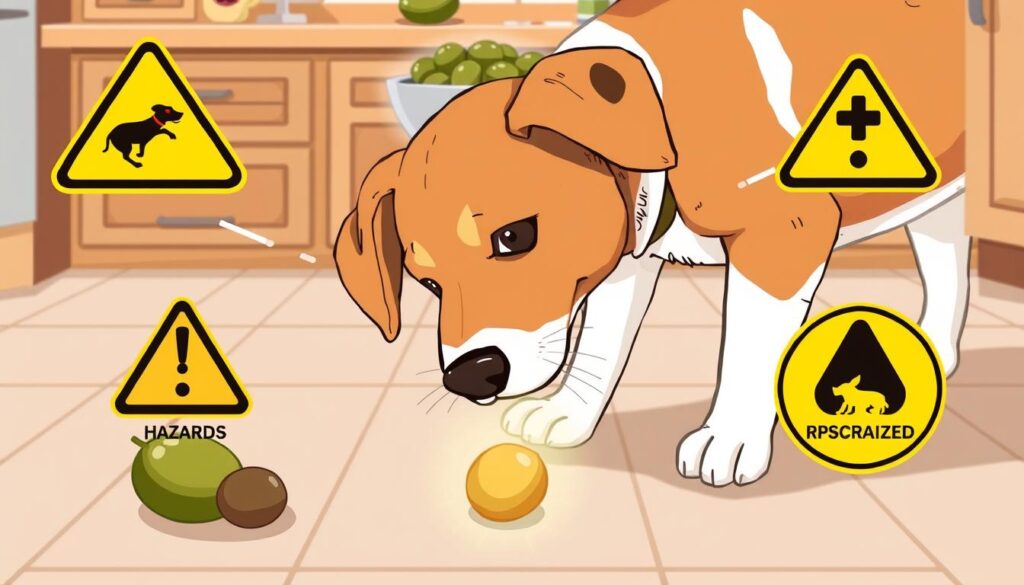Can Dogs Have Olives? Canine Diet Tips
As a pet owner,you want to offer your pet the finest care. This includes a balanced and nutritious diet. It’s essential to understand which foods from your plate are safe for dogs.
Many people wonder, “Can dogs have olives?” The answer is yes, but with caution. Plain, unsalted olives can be a healthy treat for dogs in small amounts. They have good fats, antioxidants, and minerals like copper and iron.
In this guide, we’ll look into whether dogs can safely eat olives. We’ll also talk about the benefits and precautions for your dog’s health. By the end, you’ll know how to safely add olives to your dog’s diet, if it’s right for them.
Table of Contents
Are Olives Safe for Dogs to Eat?
It’s crucial to be careful when giving olives to dogs. Olives can be tasty, but they need careful thought to keep your dog safe. Knowing the good and bad of olives is key.

Plain, Unsalted Olives: The Safest Option
Plain, unsalted olives are the safest for dogs. They have less sodium and no harmful seasonings. Giving them these olives in small amounts can help their joints, brain, and immune system.
Removing the Pit: A Must for Dog Safety
Always take out the pit before giving olives to dogs. Pits can choke or block their intestines. It’s vital for your dog’s safety.
Olives can be a nice treat for dogs, but only in small amounts. Too many can cause dehydration, imbalance, and pancreatitis. Monitor your dog’s reaction to any new foods.
Nutritional Benefits of Olives for Dogs
Olives are good for your dog’s health. They are full of healthy monounsaturated fats that can lower cholesterol and reduce inflammation. They also have fiber for better digestion and antioxidants like vitamin E and polyphenols to boost the immune system and protect cells.

Dr. Christopher Reeder, DVM, says olive oil can make your dog’s skin and coat healthier. You might see changes in about 30 days. Dogs with allergies to pollen, dust, and flea saliva might also benefit from olive oil’s anti-inflammatory effects.
The monounsaturated fats in olive oil can help with weight management. They can break down fat cells, helping with weight loss or preventing obesity. Olive oil also has antioxidants like vitamin E, which can protect cells from damage and lower disease risks like heart disease and cancer.
But, it’s important to introduce olives slowly and watch your dog’s reaction. Olives can cause stomach upset and pancreatitis if eaten too much.
In summary, olives can be great for your dog’s diet. They offer healthy fats, fiber, and antioxidants for overall health. Always talk to your vet before adding olives to your dog’s food to ensure the right amount and type.
Potential Risks of Feeding Olives to Dogs
Olives can be a tasty treat for dogs, but there are risks. They are high in fat and sodium. This can harm your dog’s health if they eat too much.
High-Fat and Sodium Content
A diet with too much fat can make dogs obese. This can result in conditions like diabetes and heart disease. The sodium in olives can also cause dehydration and electrolyte imbalances.
This can lead to vomiting, diarrhea, tremors, seizures, and even death in severe cases.
Gastrointestinal Upset and Pancreatitis
Olives can upset a dog’s stomach, causing diarrhea or vomiting. The fat in olives can also cause pancreatitis. This is a painful inflammation of the pancreas that can be dangerous.
The risks of giving olives to dogs depend on their size, age, and health. Get your vet’s advice before changing your dog’s diet with new foods.
To reduce risks, give plain, unsalted olives in small amounts as treats. Don’t give your dog olives with garlic, onions, or alcohol. These can be harmful to dogs.
Types of Olives Safe for Dogs
Choosing the right type of olive is key when feeding your dog. Plain, unsalted green and black olives are the safest choices. They have less sodium and no harmful seasonings.
Stay away from pickled olives and those with garlic or other flavorings. These can be risky for your dog. Always give olives in small amounts as an occasional treat.
| Olive Variety | Safety for Dogs | Sodium Content | Potential Risks |
|---|---|---|---|
| Plain, Unsalted Green Olives | Safest Option | Moderate | None, when fed in moderation |
| Plain, Unsalted Black Olives | Safest Option | Lower | None, when fed in moderation |
| Pickled Olives | Not Recommended | High | Sodium Toxicity, Dehydration |
| Olives with Added Flavorings (Garlic, Herbs, Spices) | Not Recommended | Moderate to High | Potential Toxicity, Gastrointestinal Upset |
Start with small amounts of safe olives for dogs and watch for reactions. Talk to your vet before adding green olives or black olives to your dog’s diet.
Are Olives Toxic to Dogs?
Olives are not toxic to dogs, but there are some things to watch out for. The part of the olive that’s safe for dogs to eat is the flesh. But, it’s key to be careful about the risks of eating olives.
The biggest danger is the pit. It can block your dog’s intestines or even choke them. Always take out the pit before giving olives to your dog. Also, olives have a lot of fat, which can upset your dog’s stomach or even cause pancreatitis.
| Olive Component | Safety for Dogs |
|---|---|
| Olive Flesh | Generally safe in moderation |
| Olive Pit | Potential choking hazard and intestinal blockage |
| Olive Oil | Safe in small amounts, provides beneficial nutrients |
| Stuffed Olives | May contain toxic ingredients like onions, garlic, or blue cheese |
Even though olive flesh is mostly safe, the fat and salt can still be harmful. Especially for dogs with health issues. Begin with a small amount and see how your dog responds.
Stick to plain, pitted olives. Don’t give your dog olives that are stuffed or have added flavors. It’s important to check with your vet before offering your dog new foods.
What should I expect if my dog eat an olive pit?
If your dog eats an olive pit, it’s a serious issue. The pit can block their airway or cause a blockage in their intestines. Since dogs can’t digest olive pits, they can get stuck and cause a lot of pain and other health problems.
Smaller dogs are at a higher risk. The pit might block their airway or get stuck in their intestines. Even if it passes through, it can still hurt their insides.
- Symptoms of olive pit ingestion may include difficulty breathing, excessive drooling, vomiting, and abdominal pain or discomfort.
- If your dog shows any of these signs after eating an olive pit, seek immediate veterinary attention, as prompt medical care may be necessary to prevent life-threatening complications.
It’s important to keep your dog away from olive pits. Watch out when you’re preparing olives and never leave them where your dog can get them. Using pitted olives or removing the pits yourself can help keep your dog safe.
| Potential Hazards of Olive Pits for Dogs | Risks |
|---|---|
| Choking | The pit can become lodged in the dog’s throat, causing breathing difficulties and potential suffocation. |
| Intestinal Blockage | If the pit is swallowed, it can obstruct the dog’s digestive tract, leading to painful and potentially life-threatening intestinal blockage. |
| Internal Injuries | As the pit passes through the digestive system, it can cause lacerations or perforations to the esophagus, stomach, or intestines. |

Knowing the dangers and taking steps to prevent them can keep your dog safe. This way, you can avoid the stress and cost of dealing with olive pit problems.
can dogs have olives: Moderation is Key
Introducing olives to your dog’s diet should be done with care. Olives can offer health benefits, but only in small amounts. These should never take the place of their daily meals.
Start Slowly and Monitor Reactions
Start with a tiny piece of plain, pitted olive. Watch your dog for any signs of upset stomach. Some dogs might not handle the fat and sodium well, so start slow.
Plain, Pitted Olives Only
If your dog does okay with plain olives, you can give them a bit more. But always choose plain, unsalted olives. Avoid any with garlic, onions, or blue cheese, as they can be harmful.
Remember, moderation is key when giving olives to your dog. Start with a little, watch how they react, and only give plain, pitted olives for their safety.
Expert Insights on Feeding Olives to Dogs
It’s tempting to share snacks with our dogs, but caution is key. Pet insurance data shows claims for the wrong foods average $642. This highlights the need to research before adding new foods to your dog’s diet.
Experts say plain, unsalted olives are safe for dogs in small amounts. Extra virgin olive oil can prevent skin dryness, soothe flaky skin, support heart health, and reduce inflammation in dogs. It can also make a dog’s coat shine after about 30 days.
The right amount of olive oil is one teaspoon per 20 pounds of body weight per meal. Or, a tablespoon once or twice a week. Some vets suggest starting with one teaspoon per 30 to 40 pounds. Always watch how your dog reacts and adjust the amount as needed.
Choosing high-quality, unprocessed olive oil is key. Extra virgin or unprocessed olive oil is best because it’s more nutritious and safe for dogs.
While olive oil is good for dogs, always check with your vet first. They can help ensure the food is right for your dog’s needs. By following expert advice, you can keep your dog healthy and happy.
Key Takeaways for Safely Feeding Olives to Dogs
Feeding olives to dogs needs care and moderation. Olives can be good for dogs, but owners must watch their health. Keeping their health in mind is essential.
Here are the top key tips for feeding olives to dogs:
- Always remove the olive pit before feeding, as it can pose a choking hazard or cause intestinal blockage if swallowed.
- Choose plain, unsalted olives to avoid the potential risks associated with high sodium content. Marinated, stuffed, or alcohol-soaked olives should be avoided.
- Start with small portions, such as one or two olives, and monitor your dog’s reaction. High fat and sodium levels in olives can lead to issues like sodium ion poisoning, obesity, diabetes, and heart disease.
- Consult your veterinarian before adding olives to your dog’s diet, as they can provide personalized veterinary recommendations based on your pet’s specific needs and health status.
By following these key tips for feeding olives to dogs, you can safely add this treat to their diet. Remember, it’s all about moderation. Your vet is the best resource when you have any worries.
Conclusion
Olives can be a good snack for dogs if given in small amounts and with care. Knowing the good and bad points helps you give them to your dog safely. Always take out the pit and pick plain, unsalted olives. Notice how your dog interacts with them.
Olives have some health benefits, but they shouldn’t be a regular part of your dog’s diet. Too many olives can cause stomach problems and other health issues. So, it’s important to keep an eye on how much you give them.
When giving olives to your dog, remember a few key things. Choose plain, unsalted olives and always remove the pit. Start with a little bit and watch how your dog does. Following these steps makes giving olives to your dog safe and healthy.







